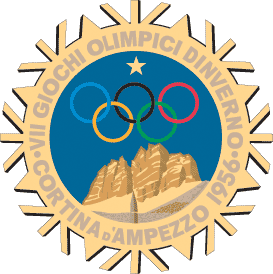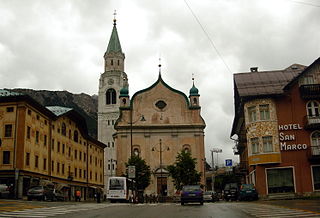
Ladin is a Romance language of the Rhaeto-Romance subgroup, mainly spoken in the Dolomite Mountains in Northern Italy in the provinces of South Tyrol, Trentino, and Belluno, by the Ladin people. It exhibits similarities to Swiss Romansh and Friulian.

The 1956 Winter Olympics officially known as the VII Olympic Winter Games, was a multi-sport event held in Cortina d'Ampezzo, Italy, from 26 January to 5 February 1956.

Cortina d'Ampezzo, commonly referred to as Cortina, is a town and comune in the heart of the southern (Dolomitic) Alps in the Veneto region of Northern Italy. Situated on the Boite river, in an alpine valley, it is a winter sport resort known for its skiing trails, scenery, accommodation, shops and après-ski scene, and for its jet set and Italian aristocratic crowd.

The Province of Belluno is a province in the Veneto region of Italy. Its capital is the city of Belluno.

Cadore is a historical region in the Italian region of Veneto, in the northernmost part of the province of Belluno bordering on Austria, the Trentino-Alto Adige/Südtirol and Friuli-Venezia Giulia. It is watered by the Piave River which has its source in the Carnic Alps. Once an undeveloped and poor district, the former contado (countship) of Cadore now has a thriving economy based on tourism and a small manufacturing industry, specialising in the production of glasses.

Badia is a comune (municipality) in South Tyrol, northern Italy. It is one of the five Ladin-speaking communities of the Val Badia which is part of the Ladinia region.

The Dolomites Railway, originally the Ampezzaner Bahn or Ampezzaner Railway, was a railway in Northern Italy crossing the Dolomites mountains. The 64.9-kilometre (40.3-mile) long railway began in Calalzo and ended in Toblach. Its gauge was 950 mm — "Italian metre gauge". The Cortina d'Ampezzo - Toblach part was closed in 1962 and the Cortina d'Ampezzo - Calalzo di Cadore in 1964. Two EMUs went to the Trento - Malè railway and are still in use. Other vehicles went to the Apulo-Lucane railway.

The Eugenio Monti olympic track is a bobsleigh and skeleton track located in Cortina d'Ampezzo, Italy. It is named after Eugenio Monti (1928–2003), who won six bobsleigh medals at the Winter Olympic Games between 1956 and 1968 and ten medals at the FIBT World Championships between 1957 and 1966. It was featured in the 1981 James Bond film For Your Eyes Only, held after the 1981 FIBT World Championships, before the track was shortened to its current configuration. In January 2008, after a last bobsleigh race tournament, the track was closed.

The Monte Cristallo is a mountain in the Italian Dolomites, northeast of Cortina d'Ampezzo, in the province of Belluno, Veneto, northern Italy. It is a long, indented ridge with four summits higher than 3,000 metres. The mountain range is part of the "Natural Park of the Ampezzo Dolomites".

Cinque Torri comprise a small rock formation belonging to Nuvolao group in the Dolomiti Ampezzane north-west of San Vito di Cadore and south-west of Cortina d'Ampezzo.

Stadio della neve was a temporary stadium located in Cortina d'Ampezzo, Italy. Located in the Campo di Sotto area, the venue hosted the cross-country skiing and the cross-country skiing part of the Nordic combined events for the 1956 Winter Olympics.
For the 1956 Winter Olympics in Cortina d'Ampezzo, Italy, a total of eight sports venues were used. All of the venues used were new or rebuilt. To make use of television coverage for the first time in the Winter Olympics, the cross-country skiing stadium was constructed to allow the best coverage. Five of the venues used for these games would appear in the James Bond film For Your Eyes Only twenty-five years later.

Ladinia is neologism used to describe an Alpine region in the Dolomites mountain range of Northern Italy, divided between the Italian provinces of Belluno, South Tyrol, and Trento. The area takes its name from its inhabitants, the Ladin people, a Romance-speaking ethnic group. Their Ladin language is generally considered a Rhaeto-Romance language, though there is a scientific debate if it forms part of a wider Northern Italian dialect continuum.

Tre Sassi fort is a fortress and museum on the road to the Passo di Valparola, within the comune of Cortina d'Ampezzo in the southern (Dolomitic) Alps of the Veneto region of Northern Italy. Hidden between the Ampezzo valley and the high Val Badia, it was built by Austrians between 1897 and 1901 as a fortification against attack from the Italians on the Falzàrego and Valparo. During World War I it was a favorite target for the Italians, and the fort was destroyed as there was inadequate artillery to defend it.

Sacrario militare di Pocol is a cemetery and shrine near the Falzarego Pass, in the locality of Pocol in the comune of Cortina d'Ampezzo in the Veneto region of northern Italy. The small church and cemetery were built in 1916 as a military cemetery by the 5th Alpine group. A shrine was built in 1935 as memorial to the thousands who died during World War I on the Dolomite front. It is a massive square tower of stone, clearly visible from the entire Ampezzo valley below. The remains of 9,707 Italian soldiers and 37 Austro-Hungarian soldiers are buried in the shrine. In a crypt in the centre of the structure rests the body of general Antonio Cantore, who was awarded the gold medal for military valor.

The Boite is a river of the Province of Belluno, Veneto region, northern Italy. Passing through the town of Cortina d'Ampezzo, it joins the Piave at Perarolo di Cadore. The principal valley, that of the Piave, runs parallel to the mountain chain which separates the province of Belluno from the basin of the Adige. The secondary valleys, which complete the river basin, are, in descending order and on the right bank, those of Visdende, Comelico Superiore, Auronzo, Boite and Zoldo, traversed, respectively, by the Silvella, or first branch of the Piave, the Padola, Ansiei, Boite, and Mae, which all flow into the main river in a rectangular direction.

Basilica Minore dei Santi Filippo e Giacomo is a Roman Catholic basilica located in Cortina d'Ampezzo, Italy. It is dedicated to the Apostles Philip and James, patron saint of Cortina d'Ampezzo. It is the home of the parish and the deanery of Cortina d'Ampezzo. Built between 1769 and 1775 in the Baroque style to a design by the architect Joseph Promperg, it sits on the site where two previous churches had existed from the 13th and 16th centuries.

Cappella della Beata Vergine di Lourdes is a Roman Catholic chapel located in Cortina d'Ampezzo's Grava di Sotto neighborhood. Built in 1907, it contains elements by the artist Corrado Pitscheider of the Val Gardena. Its feast day is celebrated on 11 February. The interior features a spacious nave, an altar, and the Lourdes grotto. The space is lit by large windows. There are statues of the Virgin and Santa Bernadette, as well as St. Lucia and St. Michael the Archangel. A framed canvas of St. Joseph with the Child hangs in the presbytery.

Milan–Cortina d'Ampezzo 2026 was a successful bid for the 2026 Winter Olympics by the cities of Milan and Cortina d'Ampezzo and the Italian National Olympic Committee. The IOC selected Milan-Cortina d'Ampezzo to host the 2026 Winter Olympics at the 134th IOC Session in Lausanne, Switzerland on June 24, 2019.

The White War, is the name given to the fighting in the high-altitude Alpine sector of the Italian front during the First World War, principally in the Dolomites, the Ortles-Cevedale Alps and the Adamello-Presanella Alps. More than two-thirds of this conflict zone lies at an altitude above 2,000m, rising to 3905m at Mount Ortler. In 1917 New York World correspondent E. Alexander Powell wrote: “On no front, not on the sun-scorched plains of Mesopotamia, nor in the frozen Mazurian marshes, nor in the blood-soaked mud of Flanders, does the fighting man lead so arduous an existence as up here on the roof of the world.”



















